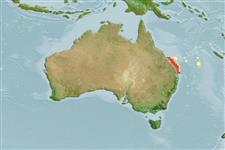Classification / Names
Nombres comunes | Sinónimos | Catalog of Fishes(Género, Especie) | ITIS | CoL | WoRMS | Cloffa
>
Pleuronectiformes (Flatfishes) >
Soleidae (Soles)
Etymology: Aseraggodes: Greek, aggos, -eos, -ous = vessel, uterus, carapace of a crab + Greek, aseros, -a, -on = to remove the appetite (Ref. 45335).
More on author: Chabanaud.
Environment: milieu / climate zone / depth range / distribution range
Ecología
marino demersal; rango de profundidad 15 - 27 m (Ref. 57560). Tropical; 22°S - 27°S (Ref. 57560)
Distribución
Países | Áreas FAO | Ecosistemas | Ocurrencias, apariciones | Point map | Introducciones | Faunafri
Western Central Pacific: Australia.
Tamaño / Peso / Age
Maturity: Lm ? range ? - ? cm
Max length : 13.2 cm TL macho / no sexado; (Ref. 56490)
Short description
Morfología | Morfometría
Radios blandos dorsales (total): 64-71; Radios blandos anales: 50 - 52; Vértebra: 35 - 36. Diagnosis. Dorsal rays 64-71; anal rays 50-52; dorsal and anal rays unbranched; pelvic rays 5; caudal rays 18, 14 branched. Lateral-line scales 68-73 (counted to origin of dorsoanterior branch on head). Only tips of cteni projecting beyond posterior edge of scales, with at most 8 cteni tips posteriorly on body, fewer anteriorly. Eyes separated by 3 rows of scales at narrowest place, with an additional row medially and anteriorly on each eye. Vertebrae 35-36 (usually 35); dorsal pterygiophores anterior to fourth neural spine 10-11. Body depth 2.3-2.55 in SL; head length (HL) 4.4-4.8 in SL; snout length 2.3-2.5 in HL. Scales anteriorly on head replaced by slender cirri, progressively longer, those at ventral edge of head and front of snout up to three-fourths eye diameter in length. Lateral line aligned with dorsal edge of upper eye, ending with a dorsoanterior branch of 7-9 pored scales, straight branch of 4-6 scales, and ventral branch of 7-9 scales; no pores detected beneath scales on ocular side of body. Eye diameter 5.0-6.5 in HL; upper eye overlapping anterior one-half to three-fourths of lower eye; narrowest vertical interorbital space 8.2-9.0 in HL; upper end of gill opening at level of ventral fleshy edge of lower eye: tubular anterior nostril broad, not reaching fleshy base of lower eye when laid back. Caudal peduncle absent, depth at base of caudal fin 1.55-1.8 in HL; caudal fin rounded, its length 4.1-4.5 in SL. Longest dorsal ray 1.35-1.5 in HL; blind side of dorsal and anal rays with a lengthwise thin membranous ridge, broad at base and narrowing as it extends up to three-fourths ray length anteriorly, progressively shorter and narrower posteriorly; edge of membrane on anterior rays of blind side of dorsal fin with cirri; pelvic fins 1.9-2.05 in HL, the tip of longest ray extending to base of second or third anal ray; ocular-side pelvic fin distinctly anterior and larger than fin of blind side; both fins broadly joined by membrane from their fifth rays and jointly to the large genital papilla about one-half length above its base. Color in alcohol light brown, densely dotted with black and short black scale edges; scattered roundish pale spots smaller than eye variously present, some free of black dots; median fins with black dots, but fewer than on body; one specimen with a few large dark blotches on lateral line and on either side of lateral line (Ref. 57560).
Life cycle and mating behavior
Madurez | Reproducción | Puesta | Huevos | Fecundidad | Larva
Kailola, P.J., 1991. The fishes of Papua New Guinea: a revised and annotated checklist. Vol. III. Gobiidae to Molidae. Research Bulletin No. 41, Research Section, Dept. of Fisheries and Marine Resources, Papua New Guinea. 153 p. (Ref. 6771)
IUCN Red List Status (Ref. 130435)
Threat to humans
Harmless
Human uses
Más información
PaísesÁreas FAOEcosistemasOcurrencias, aparicionesIntroduccionesStocksEcologíaDietacomponentes alimenticiosconsumo de alimentoRación
Nombres comunesSinónimosMetabolismoDespredadoresEcotoxicologíaReproducciónMadurezPuestaAgregación para la puestaFecundidadHuevosEgg development
Age/SizeCrecimientoLength-weightLength-lengthLength-frequenciesMorfometríaMorfologíaLarvaDinámica larvariaReclutamientoAbundanciaBRUVS
ReferenciasAcuiculturaPerfil de acuiculturaRazasGenéticaElectrophoresesheritabilidadEnfermedadesProcesamientoNutrientsMass conversion
ColaboradoresImágenesStamps, Coins Misc.SonidosCiguateraVelocidadTipo de nataciónSuperficie branquialOtolitosCerebrosVisión
Herramientas
Special reports
Download XML
Fuentes de Internet
Estimates based on models
Preferred temperature (Ref.
123201): 24.3 - 24.8, mean 24.6 °C (based on 10 cells).
Phylogenetic diversity index (Ref.
82804): PD
50 = 0.5000 [Uniqueness, from 0.5 = low to 2.0 = high].
Bayesian length-weight: a=0.00977 (0.00473 - 0.02021), b=3.07 (2.90 - 3.24), in cm total length, based on LWR estimates for this (Sub)family-body shape (Ref.
93245).
Nivel trófico (Ref.
69278): 3.6 ±0.5 se; based on size and trophs of closest relatives
Resiliencia (Ref.
120179): Alto, población duplicada en un tiempo mínimo inferior a 15 meses (Preliminary K or Fecundity.).
Fishing Vulnerability (Ref.
59153): Low vulnerability (10 of 100).
